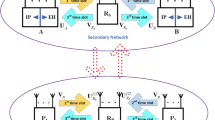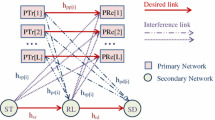Abstract
In this paper, we consider a two-way cognitive radio network where an energy-constrained secondary transmitter (ST) first performs energy accumulation and then assists bidirectional communication for a pair of primary users (PUs) based on the principle of two-way relaying (TWR) strategy. To be specific, the ST can harvest energy from the received radio frequency (RF) signals broadcasting by both the primary users. After the residual energy at the ST is sufficient for data transmission, the ST will forward PUs’ signals by using decode-and-forward (DF) manner. In return, the ST is allowed to access the primary spectrum for its own data transmission. Moreover, according to whether the ST can correctly decode PUs’ signals or not, the ST will opportunistically switch between the silent mode and data transmission mode. A discrete Markov chain is used to simulate the charging and discharging processes of the ST’s battery. Based on this, closed-form expressions of outage probabilities for both the primary and secondary systems are derived. In addition, the optimal sub-slot switching coefficient and power allocation coefficient are determined by maximizing the spectrum efficiency of the secondary system while the spectrum efficiency of the primary system exceeding a given threshold. Numerical results not only validate the accuracy of the analytical results but also show that the proposed spectrum sharing protocol can provide a better performance in terms of energy efficiency over other similar TWR schemes.











Similar content being viewed by others
References
Agiwal M, Roy A, Saxena N (2016) Next generation 5G wireless networks: A comprehensive survey. IEEE Communications Surveys & Tutorials 18(3):1617–1655
Xu J, Zhang R (2014) Throughput optimal policies for energy harvesting wireless transmitters with non-ideal circuit power. IEEE Journal on Selected Areas in Communications 32(2):322–332
Deng R, Liang H, Yong J, Chai B, Yang T (2017) Distributed rate control, routing, and energy management in dynamic rechargeable sensor networks. Peer-to-Peer Networking and Applications 10:425–439
Ammar A, Reynolds D (2018) Energy harvesting networks: Energy vs. data cooperation. IEEE Commun Lett 22(10):2128–2131
Ren J, Zhang Y, Deng R, Zhang N, Zhang D, Shen X (2019) Joint channel access and sampling rate control in energy harvesting cognitive radio sensor networks. IEEE Trans Emerg Top Comput 7(1):149–161
Lu X, Wang P, Niyato D, Kim DI, Han Z (2015) Wireless networks with RF energy harvesting: A contemporary survey. IEEE Commun Surv Tutor 17(2):757–789
Zhang H, Guo YX, Zhong Z, Wu W (2019) Cooperative integration of RF energy harvesting and dedicated WPT for wireless sensor networks. IEEE Microw Wirel Compon Lett 29(4):291–293
Wang L, Hu F, Ling Z, Wang B (2017) Wireless information and power transfer to maximize information throughput in WBAN. IEEE Internet Things 4(5):1663–1670
Ren J, Zhang Y, Ye Q, Yang K, Zhang K, Shen X (2016) Exploiting secure and energy-efficient collaborative spectrum sensing for cognitive radio sensor networks. IEEE Trans Wirel Commun 5(10):6813–6827
Liu Z, Yuan Y, Fu L, Guan X (2017) Outage performance improvement with cooperative relaying in cognitive radio networks. Peer Peer Netw Appl 10:184–192
Dhanasekaran S, Reshma T (2018) Full-rate cooperative spectrum sharing scheme for cognitive radio communications. IEEE Commun Lett 22(1):97–100
Hussain S, Fernando XN (2014) Performance analysis of relay-based cooperative spectrum sensing in cognitive radio networks over non-identical Nakagami-m channels. IEEE Trans Commun 62(8):2733–2746
Huang XL, Tang XW, Hu F (2020) Dynamic spectrum access for multimedia transmission over multi-user, multi-channel cognitive radio networks. IEEE Trans Multimedia 22(1):201–214
Goldsmith A, Jafar SA, Maric I, Srinivasa S (2009) Breaking spectrum gridlock with cognitive radios: An information theoretic perspective. Proc IEEE 97(5):894–914
Shah ST, Choi KW, Hasan SF, Chung MY (2016) Throughput analysis of two-way relay networks with wireless energy harvesting capabilities. Ad Hoc Netw 53:123–131
Lim DW, Kang J, Chun CJ, Kim HM (2019) Joint transmit power and time-switching control for device-to-device communications in SWIPT cellular networks. IEEE Commun Lett 23(2):322–325
Jang S, Lee H, Kang S, Oh T, Lee I (2018) Energy efficient SWIPT systems in multi-cell MISO networks. IEEE Trans Wirel Commun 17(12):8180–8194
Ju H, Zhang R (2014) Throughput maximization in wireless powered communication networks. IEEE Trans Wirel Commun 13(1):418–428
Wang Z, Chen Z, Xia B, Luo L, Zhou J (2016) Cognitive relay networks with energy harvesting and information transfer: Design, analysis, and Optimization. IEEE Trans Wirel Commun 15(4):2562–2576
Verma DK, Chang RY, Chien FT (2017) Energy-assisted decode-and-forward for energy harvesting cooperative cognitive networks. IEEE Trans Cogn Commun Netw 3(3):328–342
Song C, Lee H, Lee KJ (2019) Optimal precoder designs for sum-utility maximization in SWIPT-enabled multi-user MIMO cognitive radio networks. IEEE Syst J 13(3):2332–3242
Sboui L, Ghazzai H, Rezki Z, Alouini MS (2016) Precoder design and power allocation for MIMO cognitive radio two-way relaying systems. IEEE Trans Commun 64(10):4111–4120
Bastami AH, Habibi S (2018) Cognitive MIMO two-way relay network: Joint optimal relay selection and spectrum allocation. IEEE Trans Veh Technol 67(7):5937–5952
Wang Z, Chen Z, Yao Y, Xia B, Liu H (2014) Wireless energy harvesting and information transfer in cognitive two-way relay networks, IEEE Global Communications Conference, pp 3465–3470
Mukherjee A, Acharya T, Khandaker MRA (2018) Outage analysis for SWIPT-enabled two-way cognitive cooperative communications. IEEE Trans Veh Technol 67(9):9032–9036
Ye Y, Shi L, Chu X, Zhang H, Lu G (2019) On the outage performance of SWIPT-based three-step two-way DF relay networks. IEEE Trans Veh 68(3):3016–3021
Zhao W, She R, Bao H (2019) Security energy efficiency maximization for two-way relay assisted cognitive radio NOMA network with self-interference harvesting. IEEE Access 7:74401–74411
Zhang Z, Lu Y, Huang Y, Zhang P (2020) Neural network-based relay selection in two-way SWIPT-enabled cognitive radio networks. IEEE Trans Veh Technol 69(6):6264–6274
Goldsmith A (2005) Wireless communications. Cambridge University Press, Cambridge
Zhang X, Wang Y, Zhou F, Al-Dhahir N, Deng X (2018) Robust resource allocation for MISO cognitive radio networks under two practical non-linear energy harvesting models. IEEE Commun Lett 22(9):1874–1877
Xu D, Li Q (2017) Joint power control and time allocation for wireless powered underlay cognitive radio networks. IEEE Trans Cogn Commun Netw 6(3):294–297
Skog I, Handel P (2010) Synchronization by two-way message exchanges: Cramr-Rao bounds, approximate maximum likelihood, and offshore submarine positioning. IEEE Trans Signal Process 58(4):2351–2362
Salem A, Musavian L (2018) Adaptive transmissions policy for energy harvesting relay systems, International Wireless Communications and Mobile Computing Conference, Limassol, Cyprus, pp 1203–1207
Psomas C, Krikidis I (2019) Energy beamforming in wireless powered mmWave sensor networks. IEEE J Sel Areas Commun 37(2):424–438
Zhai C, Zhang W, Ching PC (2013) Cooperative spectrum sharing based on two-path successive relaying. IEEE Trans Commun 61(6):2260–2270
Acknowledgments
This work was supported by the Research Foundation of China Postdoctoral Science Foundation under Grant No. 2019 M652895, in part by the National Natural Science Foundation of China under Grant No. 61931009, in part by the Research Foundation of Education Department of Hunan Province under No. 18B517.
Author information
Authors and Affiliations
Corresponding author
Additional information
Publisher’s note
Springer Nature remains neutral with regard to jurisdictional claims in published maps and institutional affiliations.
Appendix
Appendix
1.1 Proof of Proposition 1
We define g1 = ηP1|hP1, ST|2 and g2 = ηP2|hP2, ST|2, where g1 and g2 follow the exponential distribution with mean \( {\overline{\lambda}}_1=\eta {P}_1{\lambda}_{P1, ST} \) and \( {\overline{\lambda}}_2=\eta {P}_2{\lambda}_{P2, ST} \), respectively. Thus, the amount of harvested energy E0 is the sum of two exponential random variables and the joint probability distribution of g1 and g2 is given by
where \( {f}_{G_1}\left({g}_1\right) \) and \( {f}_{G_2}\left({g}_2\right) \) denote the probability density functions (p.d.f.) of g1 and g2, respectively. The first equality of (42) holds since the g1 and g2 are mutual independence. Based on (1), we can obtain that g2 = E0 − g1 and its value range is [0, E0]. Then, the p.d.f. of the harvested energy E0 can be calculated as
As a result, the c.d.f. of E0 is derived by integrating (43), which is shown as follows
Rights and permissions
About this article
Cite this article
Tang, K., Liao, S., Dong, J. et al. Spectrum sharing protocol in two-way cognitive radio networks with energy accumulation in relay node. Peer-to-Peer Netw. Appl. 14, 837–851 (2021). https://doi.org/10.1007/s12083-020-01030-0
Received:
Accepted:
Published:
Issue Date:
DOI: https://doi.org/10.1007/s12083-020-01030-0




